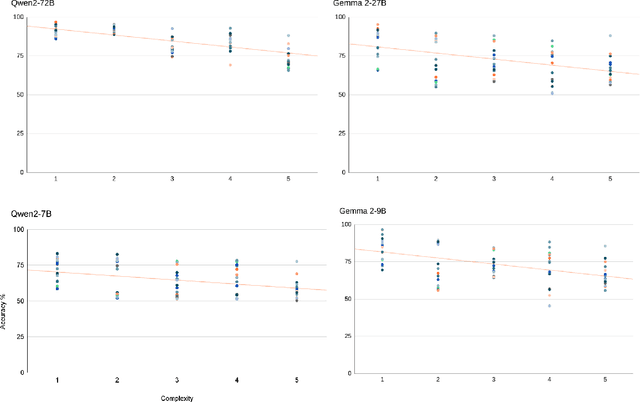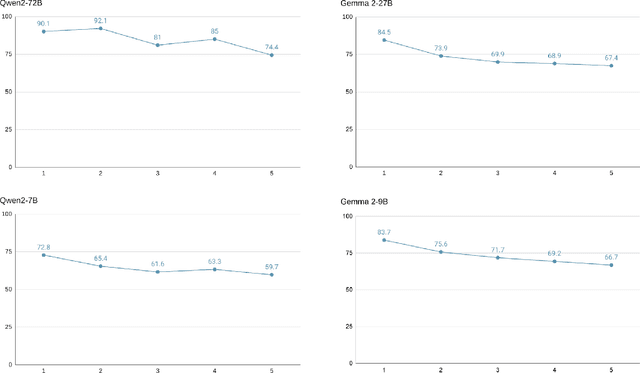R. Thomas McCoy
The Structural Sources of Verb Meaning Revisited: Large Language Models Display Syntactic Bootstrapping
Aug 17, 2025Abstract:Syntactic bootstrapping (Gleitman, 1990) is the hypothesis that children use the syntactic environments in which a verb occurs to learn its meaning. In this paper, we examine whether large language models exhibit a similar behavior. We do this by training RoBERTa and GPT-2 on perturbed datasets where syntactic information is ablated. Our results show that models' verb representation degrades more when syntactic cues are removed than when co-occurrence information is removed. Furthermore, the representation of mental verbs, for which syntactic bootstrapping has been shown to be particularly crucial in human verb learning, is more negatively impacted in such training regimes than physical verbs. In contrast, models' representation of nouns is affected more when co-occurrences are distorted than when syntax is distorted. In addition to reinforcing the important role of syntactic bootstrapping in verb learning, our results demonstrated the viability of testing developmental hypotheses on a larger scale through manipulating the learning environments of large language models.
Learning to Reason via Mixture-of-Thought for Logical Reasoning
May 21, 2025Abstract:Human beings naturally utilize multiple reasoning modalities to learn and solve logical problems, i.e., different representational formats such as natural language, code, and symbolic logic. In contrast, most existing LLM-based approaches operate with a single reasoning modality during training, typically natural language. Although some methods explored modality selection or augmentation at inference time, the training process remains modality-blind, limiting synergy among modalities. To fill in this gap, we propose Mixture-of-Thought (MoT), a framework that enables LLMs to reason across three complementary modalities: natural language, code, and a newly introduced symbolic modality, truth-table, which systematically enumerates logical cases and partially mitigates key failure modes in natural language reasoning. MoT adopts a two-phase design: (1) self-evolving MoT training, which jointly learns from filtered, self-generated rationales across modalities; and (2) MoT inference, which fully leverages the synergy of three modalities to produce better predictions. Experiments on logical reasoning benchmarks including FOLIO and ProofWriter demonstrate that our MoT framework consistently and significantly outperforms strong LLM baselines with single-modality chain-of-thought approaches, achieving up to +11.7pp average accuracy gain. Further analyses show that our MoT framework benefits both training and inference stages; that it is particularly effective on harder logical reasoning problems; and that different modalities contribute complementary strengths, with truth-table reasoning helping to overcome key bottlenecks in natural language inference.
Creativity or Brute Force? Using Brainteasers as a Window into the Problem-Solving Abilities of Large Language Models
May 16, 2025Abstract:Accuracy remains a standard metric for evaluating AI systems, but it offers limited insight into how models arrive at their solutions. In this work, we introduce a benchmark based on brainteasers written in long narrative form to probe more deeply into the types of reasoning strategies that models use. Brainteasers are well-suited for this goal because they can be solved with multiple approaches, such as a few-step solution that uses a creative insight or a longer solution that uses more brute force. We investigate large language models (LLMs) across multiple layers of reasoning, focusing not only on correctness but also on the quality and creativity of their solutions. We investigate many aspects of the reasoning process: (1) semantic parsing of the brainteasers into precise mathematical competition style formats; (2) generating solutions from these mathematical forms; (3) self-correcting solutions based on gold solutions; (4) producing step-by-step sketches of solutions; and (5) making use of hints. We find that LLMs are in many cases able to find creative, insightful solutions to brainteasers, suggesting that they capture some of the capacities needed to solve novel problems in creative ways. Nonetheless, there also remain situations where they rely on brute force despite the availability of more efficient, creative solutions, highlighting a potential direction for improvement in the reasoning abilities of LLMs.
Identifying and Mitigating the Influence of the Prior Distribution in Large Language Models
Apr 17, 2025Abstract:Large language models (LLMs) sometimes fail to respond appropriately to deterministic tasks -- such as counting or forming acronyms -- because the implicit prior distribution they have learned over sequences of tokens influences their responses. In this work, we show that, in at least some cases, LLMs actually compute the information needed to perform these tasks correctly, and we identify some interventions that can allow them to access this information to improve their performance. First, we show that simply prompting the language model to not rely on its prior knowledge leads to dramatic improvements in prior-dominated tasks. We then use mechanistic interpretability techniques to localize the prior within the LLM and manipulate the extent to which that prior influences its responses. Specifically, we show that it is possible to identify layers of the underlying neural network that correlate with the prior probability of a response and that lightweight finetuning of these layers with basic prompts on prior-dominated tasks achieves high performance on held-out answers. These results suggest that the information required to produce a correct response is contained within the representations of the problems formed by the models. Furthermore, we show that this finetuning is significantly more effective for prior-dominated tasks, and that the error after finetuning is no longer correlated with the prior. Our results suggest that it may be possible to define effective methods for manipulating the extent to which LLMs rely upon their priors in solving problems, potentially increasing their performance in settings where LLMs hallucinate for reasons related to the prior probability of token sequences.
Convolutional Neural Networks Can (Meta-)Learn the Same-Different Relation
Apr 01, 2025Abstract:While convolutional neural networks (CNNs) have come to match and exceed human performance in many settings, the tasks these models optimize for are largely constrained to the level of individual objects, such as classification and captioning. Humans remain vastly superior to CNNs in visual tasks involving relations, including the ability to identify two objects as `same' or `different'. A number of studies have shown that while CNNs can be coaxed into learning the same-different relation in some settings, they tend to generalize poorly to other instances of this relation. In this work we show that the same CNN architectures that fail to generalize the same-different relation with conventional training are able to succeed when trained via meta-learning, which explicitly encourages abstraction and generalization across tasks.
Using the Tools of Cognitive Science to Understand Large Language Models at Different Levels of Analysis
Mar 17, 2025Abstract:Modern artificial intelligence systems, such as large language models, are increasingly powerful but also increasingly hard to understand. Recognizing this problem as analogous to the historical difficulties in understanding the human mind, we argue that methods developed in cognitive science can be useful for understanding large language models. We propose a framework for applying these methods based on Marr's three levels of analysis. By revisiting established cognitive science techniques relevant to each level and illustrating their potential to yield insights into the behavior and internal organization of large language models, we aim to provide a toolkit for making sense of these new kinds of minds.
Teasing Apart Architecture and Initial Weights as Sources of Inductive Bias in Neural Networks
Feb 27, 2025Abstract:Artificial neural networks can acquire many aspects of human knowledge from data, making them promising as models of human learning. But what those networks can learn depends upon their inductive biases -- the factors other than the data that influence the solutions they discover -- and the inductive biases of neural networks remain poorly understood, limiting our ability to draw conclusions about human learning from the performance of these systems. Cognitive scientists and machine learning researchers often focus on the architecture of a neural network as a source of inductive bias. In this paper we explore the impact of another source of inductive bias -- the initial weights of the network -- using meta-learning as a tool for finding initial weights that are adapted for specific problems. We evaluate four widely-used architectures -- MLPs, CNNs, LSTMs, and Transformers -- by meta-training 430 different models across three tasks requiring different biases and forms of generalization. We find that meta-learning can substantially reduce or entirely eliminate performance differences across architectures and data representations, suggesting that these factors may be less important as sources of inductive bias than is typically assumed. When differences are present, architectures and data representations that perform well without meta-learning tend to meta-train more effectively. Moreover, all architectures generalize poorly on problems that are far from their meta-training experience, underscoring the need for stronger inductive biases for robust generalization.
Minimization of Boolean Complexity in In-Context Concept Learning
Dec 03, 2024



Abstract:What factors contribute to the relative success and corresponding difficulties of in-context learning for Large Language Models (LLMs)? Drawing on insights from the literature on human concept learning, we test LLMs on carefully designed concept learning tasks, and show that task performance highly correlates with the Boolean complexity of the concept. This suggests that in-context learning exhibits a learning bias for simplicity in a way similar to humans.
When a language model is optimized for reasoning, does it still show embers of autoregression? An analysis of OpenAI o1
Oct 02, 2024Abstract:In "Embers of Autoregression" (McCoy et al., 2023), we showed that several large language models (LLMs) have some important limitations that are attributable to their origins in next-word prediction. Here we investigate whether these issues persist with o1, a new system from OpenAI that differs from previous LLMs in that it is optimized for reasoning. We find that o1 substantially outperforms previous LLMs in many cases, with particularly large improvements on rare variants of common tasks (e.g., forming acronyms from the second letter of each word in a list, rather than the first letter). Despite these quantitative improvements, however, o1 still displays the same qualitative trends that we observed in previous systems. Specifically, o1 - like previous LLMs - is sensitive to the probability of examples and tasks, performing better and requiring fewer "thinking tokens" in high-probability settings than in low-probability ones. These results show that optimizing a language model for reasoning can mitigate but might not fully overcome the language model's probability sensitivity.
Deciphering the Factors Influencing the Efficacy of Chain-of-Thought: Probability, Memorization, and Noisy Reasoning
Jul 01, 2024Abstract:Chain-of-Thought (CoT) prompting has been shown to enhance the multi-step reasoning capabilities of Large Language Models (LLMs). However, debates persist about whether LLMs exhibit abstract generalization or rely on shallow heuristics when given CoT prompts. To understand the factors influencing CoT reasoning we provide a detailed case study of the symbolic reasoning task of decoding shift ciphers, where letters are shifted forward some number of steps in the alphabet. GPT-4 achieves zero accuracy on most shift ciphers with standard prompting, but with CoT its accuracy improves to an average of 32%. By focusing on a single relatively simple task, we are able to identify three factors that systematically affect CoT performance: the probability of the task's expected output (probability), what the model has implicitly learned during pre-training (memorization), and the number of intermediate operations involved in reasoning (noisy reasoning). We show that these factors can drastically influence the task accuracy; e.g., varying the output's probability of occurrence can shift accuracy from 26% to 70%. We also demonstrate that it is essential for the model to explicitly produce intermediate steps as output that can be conditioned on to increase the probability of the correct answer. Our experiments indicate that as long as the model does so, the validity of the demonstrations in the prompt does not matter. Overall, we conclude that CoT prompting performance reflects both memorization and a probabilistic version of genuine reasoning.
 Add to Chrome
Add to Chrome Add to Firefox
Add to Firefox Add to Edge
Add to Edge